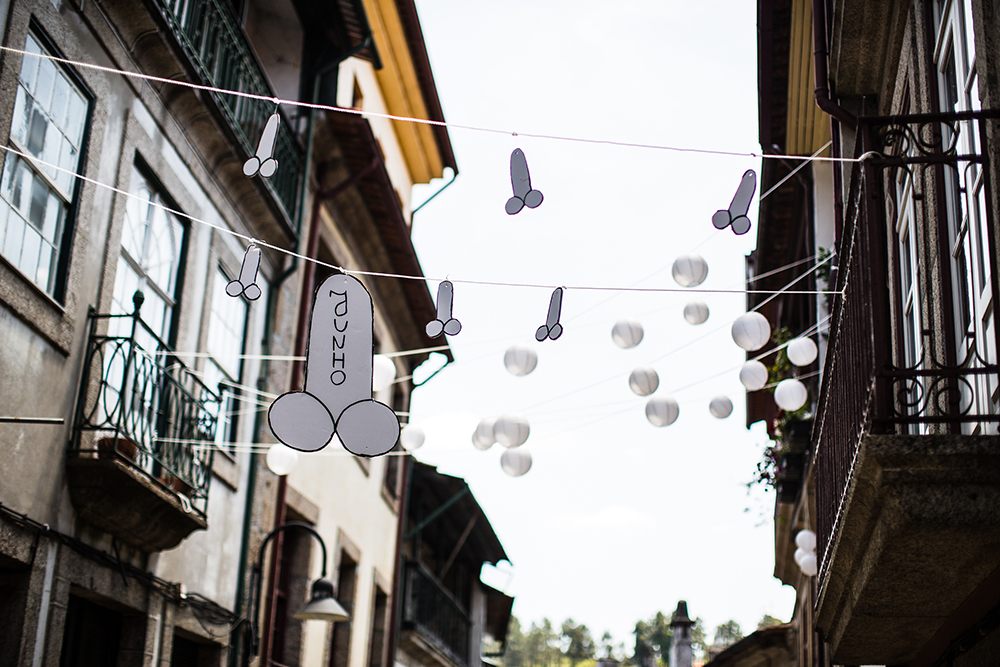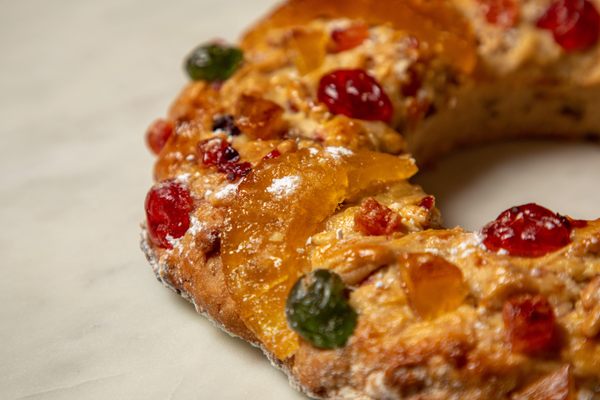How Phallic Cakes Became the Mascot of a Conservative Portuguese Town
Every baker in Amarante is in on the action.

Drums echo through the cobbled streets. The air is thick with the smell of doughnut grease, sugar, and freshly-baked pastries. Festive lights flicker overhead while a group of townsfolk in traditional dress prepare themselves for an evening of lively dancing.
Behind the table of a street stall, an old woman wearing a gingham apron and a devout expression is wrapping some penis-shaped cakes into a parcel.
It’s festival time in Amarante, a normally quiet village in the far north of Portugal, and these phallic cakes are in abundance. The street sellers lining the sidewalks have rows of them on display. These cakes are so integral to the identity of the village, in fact, that they’ve become its most recognizable icon. In their honor, phallic symbols are rife. Even the bunting overhead flutters with white paper phalluses.

But how did the erect penis become the symbol, the mascot, for a hyper-conservative Portuguese town?
The cakes are known as “Bolos de São Gonçalo” (Saint Gonçalo cakes) or sometimes “doces fálicos” (literally phallic sweets), and they’re the object of a long-standing fertility ritual. Forget the bunches of red roses: Amarante townsfolk prefer to exchange cakes shaped like erect penises as a (none-too-subtle) token of their affections. The pastries can also be bought by or gifted to single women as a love-life good luck charm. In a way the cakes are an offering to the revered saint; an edible prayer petitioning unity, fertility, and fidelity.

Exactly how the tradition originated is a mystery. São Gonçalo himself was a Roman Catholic priest who lived and died in Amarante in the 13th century. Cast out of his parish by his progressive (and rather unfriendly) nephew, Gonçalo joined the Dominican Order and lived the rest of this life as a hermit. As such, there’s little known about him that could explain his link to romance and fertility.
It’s probable that the tradition stems from pre-Christian times. Pagan practices were so deeply rooted during the time Christianity spread across Europe that it was far easier to absorb, rather than change or eradicate, them. Since phallic symbols were frequently used in Pagan fertility rituals, it’s easy to imagine the cakes as a direct descendant of those ancient rites which were, somewhere along the line, linked to São Gonçalo as a way of bringing them into Christendom.

The São Gonçalo festival is ever evolving. During the first weekend in June and on January 10, the town bursts to life with a calendar of activities that oscillates between the cheerfully modern and the deeply religious. DJs blast dance music into the streets. Intricate flower arrangements are laid at the feet of saints on religious floats. Carnival rides fling their technicolor arms into the night. Church bells call the townsfolk to a solemn Sunday mass service.
Even the cakes are evolving. There are those sold by street vendors, whose trestle tables groan under the weight of hard, edible, anatomically correct phalluses up to a meter in length. Then there are bakeries transforming the tradition into something softer, more subtle, more delectable. Some of their versions have cream fillings or come in miniature size. Capitalizing on the uniqueness of the tradition, they now produce the cakes outside the dates of the festival, too.

The cake tradition is, above all, resilient. It’s thought that during the Portuguese dictatorship, which began in 1926, the cakes were deemed obscene and against public morals. They were quickly outlawed. The people of Amarante, unwilling to give up a tradition so integral to their identity, continued to secretly make and exchange the sweets behind closed doors. When the dictatorship fell in the revolution of 1974, the cakes were once again free to stand proudly in street vendors’ carts. There they remain to this day.
Gastro Obscura covers the world’s most wondrous food and drink.
Sign up for our email, delivered twice a week.

























Follow us on Twitter to get the latest on the world's hidden wonders.
Like us on Facebook to get the latest on the world's hidden wonders.
Follow us on Twitter Like us on Facebook